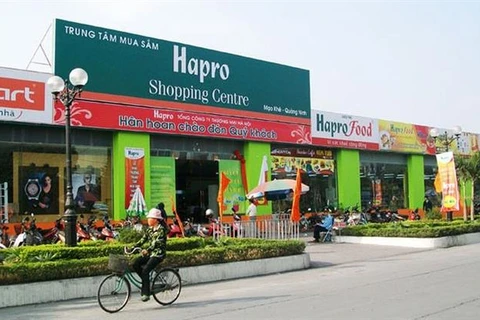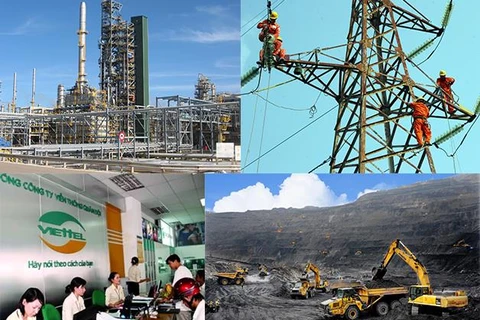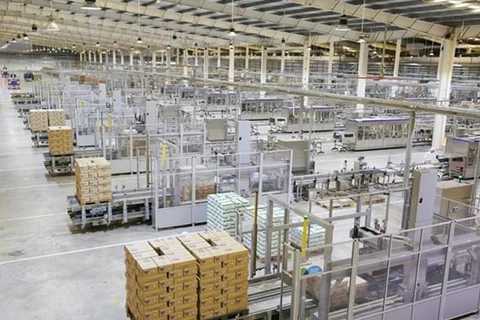 Equitisation of SOEs reaches only 28 percent of the government-approved target for the 2017-2020 period (Photo: VietnamPlus)
Equitisation of SOEs reaches only 28 percent of the government-approved target for the 2017-2020 period (Photo: VietnamPlus)
Hanoi (VNA) – Up to 92 out of the 128 targeted state-owned enterprises (SOEs) must be equitised this year under the 2017-2020 equitisation plan approved by the government.
In 2019, only nine state-owned enterprises were given the green light from the authorities for their equitisation plans and just three of them were on the list of 128 SOEs subject to equitisation under the 2017-2020 equitisation plan.
The progress was still “very slow”, said Dang Quyet Tien, Director of the Corporate Finance Department under the Ministry of Finance (MoF), at a press conference on the local financial and production situation and the restructuring and equitisation of SOEs in Hanoi on December 10.
Equitisation just meets only 28 percent of the target
Tien said though equitisation and divestment had a positive impact on the development of the stock market, improving the performance of firms, the slow progress was “concerning”.
Since 2016, 168 SOEs have had their equitisation plans approved by the government, with a combined value of more than 443.05 trillion VND (some 19.1 billion USD).
However, just 36 out of the targeted 168 SOEs have completed their equitisation plans, equivalent to 28 percent of the goal.
“Therefore, the number of SOEs subject that must conduct equitisation in 2020 amounts to 9. This shows the progress of equitisation was very slow, failing to reach the set plan,” said Tien.
The southern economic hub of Ho Chi Minh City has the largest number of SOEs subject to equitisation in 2020, with 38 SOEs (including 11 corporations), accounting for 40 percent of the total.
It is followed by the capital city of Hanoi with 13 SOEs (including four corporations), making up 14 percent of the total number.
In addition, the Committee for Management of State Capital at Enterprises (CMSC) has six SOEs (including three groups and three corporations), the Ministry of Industry and Trade has four SOEs (including three corporations) and the Ministry of Construction has two SOEs (two corporations).
Divestment of SOEs is also stagnant
At the press conference, the MoF’s report showed the divestment in SOEs since 2016 was also stagnant. Up to now, state divestment only reached 8.9 trillion VND or 7.8 percent of the plan.
Tien told the Vietnam News Agency: “Some ministries, localities, and SOEs do not seriously implement the equitisation, divestment and restructuring plans.
“Many SOEs faced difficulties and need longer period dealing with financial, land and labour problems for their equitisation.”
The MoF also reported that there were 855 firms with State capital including 505 wholly State owned firms and 350 State-invested firms with the total state capital of 1,533 trillion VND.
The total assets of these SOEs in the fiscal year of 2018 reached 3,715 trillion VND, an increase of 2 percent compared to 2017. Among them, 110 firms or 13 percent reported losses.
Tien said the ministry will ask the PM to allow it to directly review and clarify responsibilities of SOEs that failed to equitise in time. Also, to help overcome difficulties for the local equitisation process, the MoF was amending some articles in Decree No. 126/2017 / ND-CP and Decree No. 32/2018 / ND-CP./.
According to experts, the slow progress was partly due to tougher regulations on equitisation in a bid to ensure the targets, efficiency and transparency. In addition, a number of ministries, sectors and localities have faced difficulties in determining the values of land use and enterprises. Meanwhile, leaders of several SOEs have been afraid of bearing responsibility when dealing with prolonged affairs during the process of equitisation.
To actively provide information about the equitisation of SOEs and identify difficulties and obstacles during the process of implementation, ministries, sectors and localities have taken drastic measures in an effort to accomplish the set targets.
In mid-August, Prime Minister Nguyen Xuan Phuc signed Decision 26/2019/QD-TTg approving the list of 92 enterprises subject to equitisation by the end of 2020. Of those, the State holds more than 65 percent of charter capital in four enterprises, 50-65 percent of charter capital in 62 businesses, and less than 50 percent of charter capital or no stake in 27 firms.
According the decision, the Prime Minister asked the Ministry of Planning and Investment, the Ministry of Finance and the Steering Committee for Business Innovation and Development to send quarter reports and final reports before September 30, 2020.
“The equitisation must be implemented in an open and transparent manner and in line with Party Central Committee’s resolutions. The preparation is very important and the first is the awareness so SOEs should take the initiative in restructuring in conformity with Land Law, thus helping to speed up the equitisation process, said Tien.
Tien also pointed to the loose coordination between agencies representing the State capital ownership and the People’s Committees of provinces and cities. Therefore, the government needs to make clearer decentralization, he suggested./.























